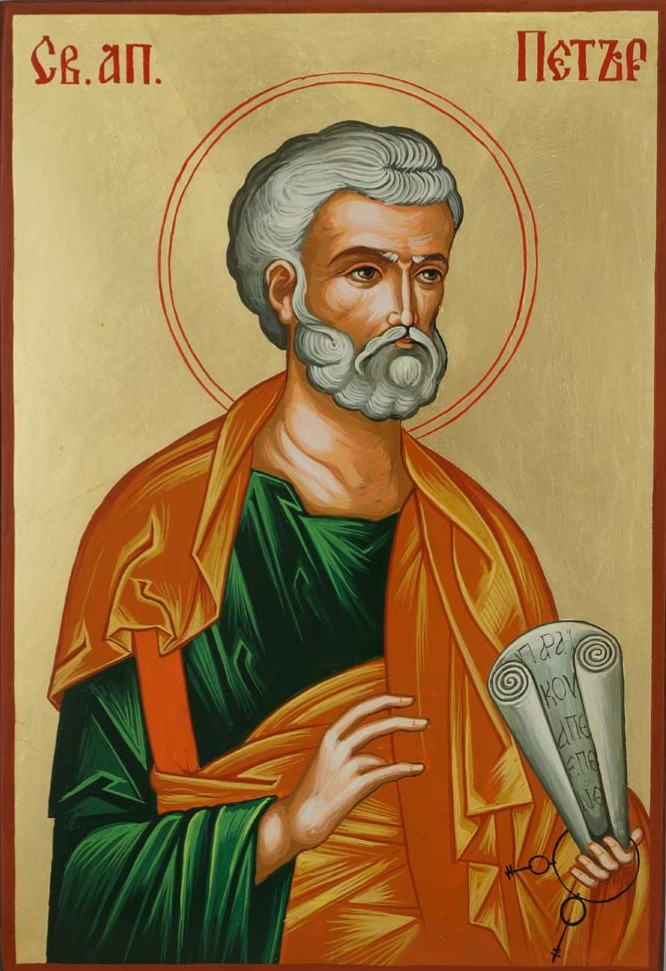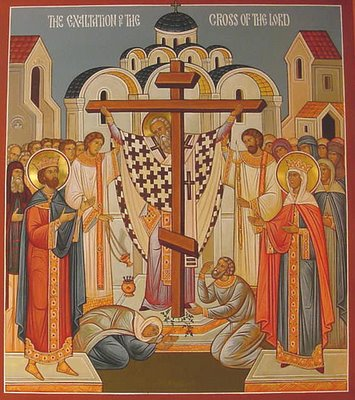Exaltation of the Holy Cross

We will celebrate the Exaltation of the Holy Cross at the end of Divine Liturgy this Sunday, September 14.
About the Exaltation of the Holy Cross
Saint Helen, the mother of Saint Constantine the Great, when she was already advanced in years, undertook, in her great piety, the hardships of a journey to Jerusalem in search of the cross, about the year 325. A temple to Aphrodite had been raised up by the Emperor Hadrian upon Golgotha, to defile and cover with oblivion the place where the saving Passion had been suffered.
The venerable Helen had the statue of Aphrodite destroyed, and the earth removed, revealing the Tomb of our Lord, and three crosses. Of these, it was believed that one must be that of our Lord, the other two of the thieves crucified with Him; but Saint Helen was at a loss which one might be the Wood of our salvation.
At the inspiration of Saint Macarius, Archbishop of Jerusalem, a lady of Jerusalem, who was already at the point of death from a certain disease, was brought to touch the crosses, and as soon as she came near to the Cross of our Lord, she was made perfectly whole.
Consequently, the precious Cross was lifted on high by Archbishop Macarius of Jerusalem; as he stood on the ambo, and when the people beheld it, they cried out, “Lord have mercy.”
It should be noted that after its discovery, a portion of the venerable Cross was taken to Constantinople as a blessing. The rest was left in Jerusalem in the magnificent church built by Saint Helen, until the year 614.
At that time, the Persians plundered Palestine and took the Cross to their own country (see Jan. 22, Saint Anastasius the Persian). Late, in the year 628, Emperor Heraclius set out on a military campaign, retrieved the Cross, and after bringing it to Constantinople, himself escorted it back to Jerusalem, where he restored it to its place.
Source: Greek Orthodox Church Online Chapel.
The Sunday Scripture Readings
The Gospel Reading

The Reading from the Holy Gospel according to St. John. (19:6-11, 13-20, 25-28, 30-35)
At that time, the chief priests and the elders of the people took counsel against Jesus to put Him to death. And they came to Pontius Pilate saying, “Crucify Him, crucify Him!” Pilate said to them, “Take Him yourselves and crucify Him, for I find no crime in Him.” The Jews answered him, “We have a law, and by that law He ought to die, because He has made Himself the Son of God.” When Pilate heard these words, he was the more afraid; he entered the praetorium again and said to Jesus, “Where art Thoufrom?” But Jesus gave no answer. Pilate therefore said to Him, “Wilt Thou not speak to me? Knowest Thou not that I have power to release Thee, and power to crucify Thee?” Jesus answered him, “You would have no power over Me unless it had been given you from above.
When Pilate heard these words, he brought Jesus outand sat down on the judgment seat at a place called “The Pavement”, and in Hebrew, “Gabbatha.” Now it was the day of Preparation of the Passover; it was about the sixth hour. He said to the Jews, “Behold your King!” They cried out, “Away with Him, away with Him, crucify Him!” Pilate said to them, “Shall I crucify your King?” The chief priests answered, “We have no king but Caesar.” Then he handed Him over to them to be crucified.
So they took Jesus and led him away, and He went out, bearing His own Cross, to the place called the place of a skull, which is called in Hebrew “Golgotha.” There they crucified Him, and with Him two others, one on either side, with Jesus between them. Pilate also wrote a title and put it on the Cross; it read, “Jesus of Nazareth, the King of the Jews.” Many of the Jews read this title, for the place where Jesus was crucified was near the city; and it was written in Hebrew, in Latin, and in Greek.
Now standing by the Cross of Jesus were His mother,and his mother’s sister, Mary the wife of Cleopas, and Mary Magdalene. When Jesus sawHis mother, and the Disciple whom He loved standing near, He said to His mother, “Woman, behold, your son!” Then He said to the Disciple, “Behold, your mother!” And from that hour the Disciple took her to his own home. After this, Jesus, knowing that all was now fulfilled, said, “It is finished’; and He bowed His head and gave up the spirit.
Since it was the day of Preparation, in order to prevent the bodies from remaining on the cross on the Sabbath (for that Sabbath was a high day), the Jews asked Pilate that their legs might be broken, and that they might be taken away.So the soldiers came and broke the legs of the first, and of the other who had been crucified with him; but when they came to Jesus and saw that He was already dead, they did not break His legs. But one of the soldiers pierced His side with a spear, and at once there came out blood and water. He who saw it has borne witness—his testimony is true.
The Epistle Reading
Exalt ye the Lord our God. The Lord reigneth; let the people tremble.
The Reading from the First Epistle of St. Paul to the Corinthians. (1:18-24)
Brethren, the word of the Cross is folly to those who are perishing, but to us who are being saved it is the power of God. For it is written, “I will destroy the wisdom of the wise, and the cleverness of the clever I will thwart.” Where is the wise man? Where is the scribe? Where is the debater of this age? Has not God made foolish the wisdom of the world?
For since, in the wisdom of God, the world did not know God through wisdom, it pleased God through the folly of what we preach to save those who believe. For Jews demand signs and Greeks seek wisdom, but we preach Christ crucified, a stumbling block to Jews and folly to Gentiles, but to those who are called, both Jews and Greeks, Christ the power of God and the wisdom of God.

